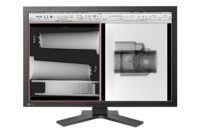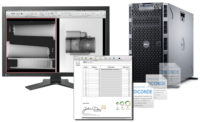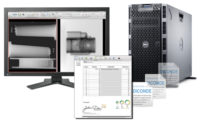Benefits of a Digital Workflow in Nondestructive Testing
Consider these benefits in going digital.

Based on DICOM (Digital Imaging and Communications in Medicine), a proven imaging and archiving standard, since 1993, DICONDE (Digital Imaging and Communication for Non-Destructive Evaluation) is an imaging and archiving technology standard that defines all image attributes and elements in a universal format. In 2004, the American Society for Testing and Materials (ASTM) E07.11 subcommittee made DICONDE the standard (E2339-11) for NDT imaging.
The NDT Digital Workflow
With the use of digital (DICONDE) technology, NDT image workflows are simpler, and more cost efficient than traditional film workflows, and provide flexibility not available with other proprietary digital workflows. From acquisition to sharing, a digital image workflow improves delivery, and report integration, for visual and radiographic NDT users.
Digital Acquisition
Unlike film processes, a digital process is flexible, allowing for the best acquisition method for each specific situation: Direct Radiography with panel detectors for low Kv and lab situations; Phosphor plates with laser scanning for digital acquisition in the field; and even film acquisition, which can be integrated using digitizers to create a digital copy.
Digital acquisition is also more environmentally friendly, and less cumbersome to use than film. For example, you don’t need all the film chemicals, you can capture images in less stringent temperature constraints, and you can avoid the need for large processing trailers.
Another key benefit of digital acquisition is that valuable data can be stored as part of the image, such as who took the images, where they were taken, when they were taken, and depending on the machine, even the kV, mA, and equipment identifiers.
Digital Transmission
Digital images can be transmitted directly from the acquisition site, or from a designated upload site, via a secure server to the inspection station. This shortens the turnaround time for image delivery, and ensures a chain of custody—no longer hours or days for transporting film, no piles of film without reference markers that fell out of their jackets, and no lost films that never make it out of the field truck. Images collected and transmitted digitally from the field can also provide valuable trend and progress data, which can help fleet managers in project planning.
Digital Review
During the review phase of the digital workflow, delivery of images is automated, which means the time it takes to reach the inspection team can be under an hour. Archive queries are quicker too with digital. Inspectors can query the archives to retrieve comparison views of reference parts, or parts with similar wear and corrosion patterns, to make more informed decisions before failures happen—requesting film from an archive vault is time consuming and inconvenient. With digital, it’s also easy to cross-reference multiple scans of a single part over multiple facilities, and multiple timeframes.
Computer aided assessment technology may be brought into a digital workflow, something not possible in traditional film environments. Computer aided assessment tools provide automated procedures for flaw detection to flag images for follow-up inspection, can make automated characteristic verifications, and can identify similarities to other failures analyzed before.
An overarching benefit of digital over film during review is the ability to better utilize expert resources in the company; for instance, you can easily connect with colleagues who can provide another set of eyes on a part.
Digital Archiving
With digital, a central archive of historical inspection data can be easily created. A central archive makes storing, pre-inspection planning, and post-inspection analysis quicker and more accurate. It also provides a platform for future re-analysis (with newer software tools), or assisting in root-cause inquiries. And, as digital systems are scalable, true enterprise level storage can be achieved bringing together in one place multiple acquisition systems that are geographically diverse. In a digital archive, data may be kept for the lifetime of the object inspected—possibly 20-plus years. During this time, migrating data to new systems, as software and hardware obsolescence occurs, or as vendors change, is easy with DICONDE because it’s a universal format.
In a digital archive, images are stored with critical metadata (part, revision, inspector) allowing for quick image search, and retrieval. Unlike film, these digital archives can retrieve images with minimal human intervention, and provide access within minutes. In traditional film environments, retrieval can take days while films are pulled from storage vaults, and sometimes from other locations across the country. Also adding to timely retrieval of archive data is the nearline digital storage method, which consists of media that remains connected but is powered up only when necessary, thus saving energy. And, unlike film, digital storage is environmentally friendly and safe. There’s no need for chemical storage, or special film jackets.
In terms of archive security, digital is ideal, particularly for highly sensitive information. Digital archiving can ensure only inspectors with a need to know are permitted access. Additional image access can be followed with audit trails showing who looked at what, where, and when, and keeping unauthorized personnel out. Plus, any digital inspection report can be stored with the image data for ease of reference. The data in storage is further safeguarded by mechanisms that verify data integrity, and prevent accidental deletion or changes. And, with a central archive, you can provide a quickly accessible reference point for proving due-diligence when mistakes are later found, or lawsuits occur.
Digital Sharing
In addition to the inherent speed of digital transmission, sharing image data is quicker with digital because all the data is included in the DICONDE image. This means that inspection service customers now have access to that valuable data. In fact, DICONDE images can be directly imported into the customer’s own DICONDE archive, allowing the same search ability. Security remains during the sharing phase of the workflow with tools that include web portals, which allow images to be securely downloaded over the Internet or private networks. And, because DICONDE is vendor agnostic, one DICONDE archive can talk directly to another DICONDE archive to share data.
Common Misconceptions About Digital Workflows
Disks are cheap and assumed safe. We heard this again at the last American Society for Nondestructive Testing conference in Charleston, SC. The reality is, the larger your storage disk becomes, the more data that will inevitably be lost when that disk drive fails. Losing that data can mean losing a lawsuit if you cannot prove an inspection was completed. This is why a proper archiving solution is critical for any environment.<
Proprietary formats have the same search and organization functions as DICONDE. This is true; however, the data is locked into that vendor’s solution. With vendor neutral DICONDE, you are free to add scanners, inspection stations, and analysis software from other vendors to best meet your needs, and easily allow secure access.
All files are created equal. Image data can be (sometimes unknowingly) stored in a format that is compressed “lossy,” where visual image data is discarded to decrease file size. This can lead to misinterpretation. DICONDE avoids this by natively storing in a lossless format, and clearly identifying when a lossy format was used.
Images stored by file/folder name are safe. The file/folder name method for image identification is commonly used, but is a very error prone method of organizing image data. It provides no safeguards to accidental file moves, renames or deletes. And data recovery in the case of a file system crash is almost impossible. Image data may be recoverable, but file/folder names are lost—leaving you with a pile of images and no idea what they are or who they belong to. DICONDE solves this because of the integrated metadata.
External hard drives stored in a file vault are safe. External hard drives on the market are designed for consumer use and have components that deteriorate on a shelf, similarly to tapes. These drives may fail to power up, and it’s only noticed when the data contained needs to be retrieved. DICONDE archives include options for special media designed for long shelf life with failure redundancy built in.
Digital is more expensive than a film workflow. While digital workflows have more of an upfront cost than film, the continued running costs are much less expensive. With the reduction, or elimination of film from the workflow, you gain all the productivity, security, and environmental benefits of digital while eliminating the expensive and ongoing cost of the film, and all its associated storage, handling and shipping.
The Future of Digital Workflows in NDT
Reports from early adapters, including many U.S. National Laboratories, are proving DICONDE to be a cost effective, productive alternative to traditional film-based systems. And, with the growing demand for more speed, security and cost reductions, we expect the trend towards digital in NDT, and elsewhere, to continue.
Looking for a reprint of this article?
From high-res PDFs to custom plaques, order your copy today!







